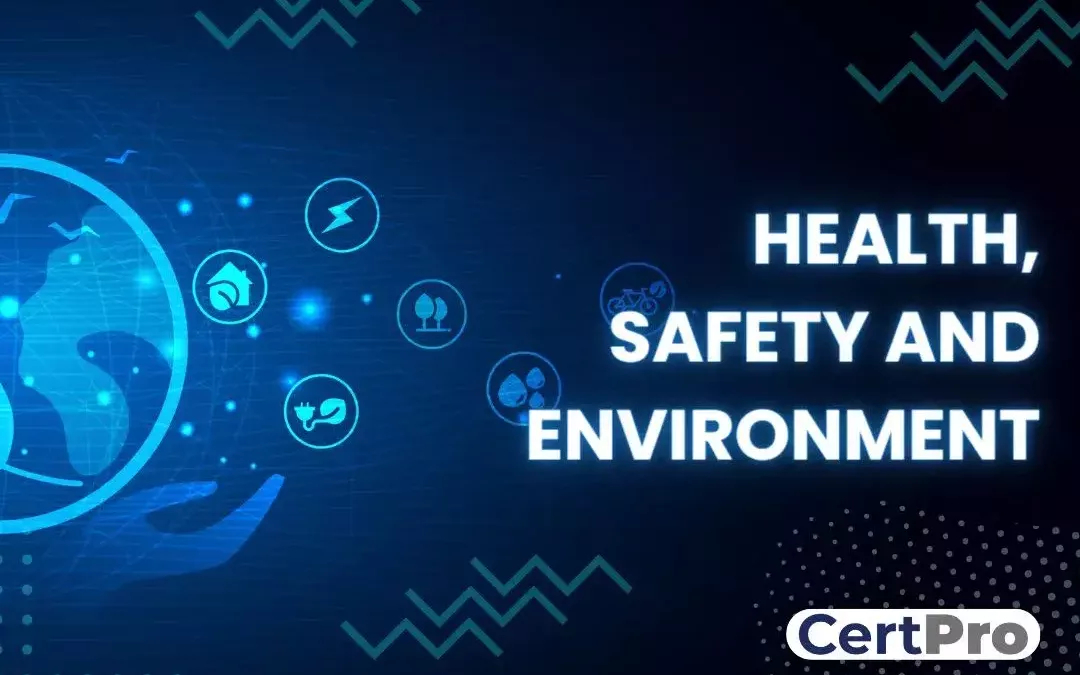Environmental Health and Safety (EHS or HSE) is a dedicated department or team in an organization with a simple and focused agenda. Here, the focus is to ensure that the activities of an organization does not cause any unwarranted environmental impact or set the employees’ or workers’ health and safety at high risk and also to ensure that the organization complies with all the necessary and applicable regulatory and legal norms.
The main intention and objective of HSE is to prevent and reduce accidents, emergencies, and health issues at work along with taking necessary measures to avoid any environmental damage that could result from work practices.
Health, safety and environment (HSE) management ensures that the health and safety of your workers are addressed as per industry norms and are compliant with HSE requirements.
Health (H) and Safety (S) and Environment (E) (HSE) is a scientific approach of studies and execution of practical factors for environmental protection and safety at work. In general terms, HSE clearly defines as to what the organizations need to do to ensure that their activities do not cause damage to anyone.
The team of Health, Safety and Environment in its scientific approach takes a systematic and empirical data and decisive approach in preventing accidents and injuries. They manage a range of hazards that could cause danger to the workforce.
The work initiated or handled by EHS (HSE) departments is driven by various factors of concerns:
- The protection of workers, their health, and the natural environment
- Mandatory compliance requirements of legal and regulatory standards
- A safe and healthy workforce improves the organization’s overall productivity, profit, and morale benefitting both the employees and the employers.
A team focused on HSE would bring certain positive measures for a better workforce environment:
- Proactive measures that prevent incidents before they convert into accidents.
- Coordinate all health and safety aspects of the workplace.
- Plan and execute health and safety initiatives and verify and validate the same for better execution.
- Comply with all relevant HSE regulations and requirements.
- Ensure the health and safety of workers, decrease accident risks and improve onsite productivity.
- Create a long-term safety culture with expert advice and recommendations for future safety maintenance.
From the safety point of view, it involves creating organized efforts and procedures for identifying workplace hazards and reducing accidents and exposure to harmful situations and substances. It also includes training of personnel in accident prevention, accident response, emergency preparedness, and use of protective clothing and equipment.
The safety measures of HSE include:
- Facility design
- Hazard identification
- Workplace inspection and corrective action
- Shutdown of dangerous activities
- Medical surveillance
- Emergency preparedness
In addition to these general safety aspects, additional hazard specific policies and requirements may be applicable as per legal and government laws and regulations.
Health aspect in HSE includes key aspects of safe, high quality and environmental friendly processes. Subsequently, it has gradually grown from a risk oriented activity to a multi-disciplinary approach that considers working practices and systemic activities like physical, mental and social wellbeing that prevent or reduce the risk of harm to people in general.
From an environmental point of view, it requires the management team of HSE to create and plan a systematic approach to comply with environmental regulations. It involves creating a systematic approach to complying with the environmental regulations and any such legal and regulatory compliance that needs to be followed as per the norms to reduce carbon footprint.

Environmental Health and Safety (EH&S) team is responsible for:
- Reviewing legislation, recommending policies and monitoring compliance with environmental, health and safety regulations, policies and programs.
- Developing safety and compliance programs with implementation plans for better execution of HSE norms.
- Providing guidance and technical assistance to supervisors and managers in schools and other work units in identifying, evaluating and correcting health and safety hazards.
- Developing programs for the safe use of hazardous radiological, biological, and chemical substances.
- Providing training materials, assistance, and programs for safe work practices;
- Providing guidance for an effective emergency management and business continuity programs.
- Providing emergency response services for incidents involving hazardous materials.
- Providing fire prevention, inspection, engineering and systems maintenance services.
Hazardous waste management and disposal services.
Responsibility of Health & Safety Executive in handling HSE includes:
- Safety coordination during the design, fabrication and construction phases
- Recommendations for preventive measures
- Coordination documents
- Safety risk analysis
- Verification and development of health and safety plans
- Internal license controls
- Verification of access permits
- Access controls for designated areas
- Certificate control for cranes and operators
- Control of collective protection
- Control of personnel protection equipment (including helmets, gloves and shoes)
- Safety signalling control
- Determination of transfer/clearing routes
- Supply of external HSE coordinators
- Guidance/coordination concerning Occupational Health and Safety regulations
- Regular recording and reporting, focused on non-conformities, corrective/preventative actions and statistical data
- Safety training courses
Benefits of Health Safety and Environment:
- Protection of Staff: Following the principles of HSE prevents probable injuries, illnesses or any kind of unexpected harm at workplace.
- Improving Productivity: Working in a safe environment means the overall morale and performance of the workforce will improve considerably.
- Cost Reduction: Following the best practices in terms of safety and maintenance reduces absentees and creates a positive impact on employee retention. This will also reduce the breakdowns at work stations, making the business more profitable by saving unwanted costs.
- Reduced irregularities among workforce: When morale is high and safety measures at work are raised, the employees tend to be more punctual and regular thereby reducing attrition among employees.
- Demonstration of HSE principles: An organization that implements HSE principles subsequently becomes a great source to showcase the commitment of the company towards the workforce in terms of health and safety.
How to get HSE management system certification?
The HSE-MS certification is an effective tool that helps companies to have a management system that is efficient in managing the health and safety factors within the company. The HSE management system combines the important factors of health, safety and environmental aspects for a business as an integral system so that it is easier for management to achieve the set goals.
In order to get a HSE-MS certification, you can approach good consulting firms to get your company assessed properly. They will guide you in getting the certification from a reputed and genuine certification body that audits your systems based on the requirements of the HSE-MS and certify the entity with the HSE-MS certification.
For more information about the standard and its certification process, please do reach out to us at www.certpro.in
UNDERSTANDING ISO 42001: A GUIDE FOR RESPONSIBLE AI MANAGEMENT SYSTEMS
The invention of artificial intelligence (AI) has changed the operational processes of many industries. However, the rapid growth of technology increases ethical, security, and privacy-related concerns. Therefore, the International Organization for Standardization...
EUROPEAN UNION’S ARTIFICIAL INTELLIGENCE ACT: HOW THIS GROUNDBREAKING LAW AFFECTS YOUR BUSINESS
Nowadays, Artificial Intelligence (AI) is transforming our lives exceptionally well. AI is now streamlining healthcare services, providing virtual assistance, and fulfilling queries. Technologies have boons and curses. Similarly, AI creates many concerns about...
How to Implement GRC Frameworks in 2024: Step-by-Step Guide
The rapidly evolving business environment, complexity, and accountability enhance the importance of the organization's governance, risk management, and compliance initiatives. Therefore, if your company finds difficulties expanding, recheck your organization's...




